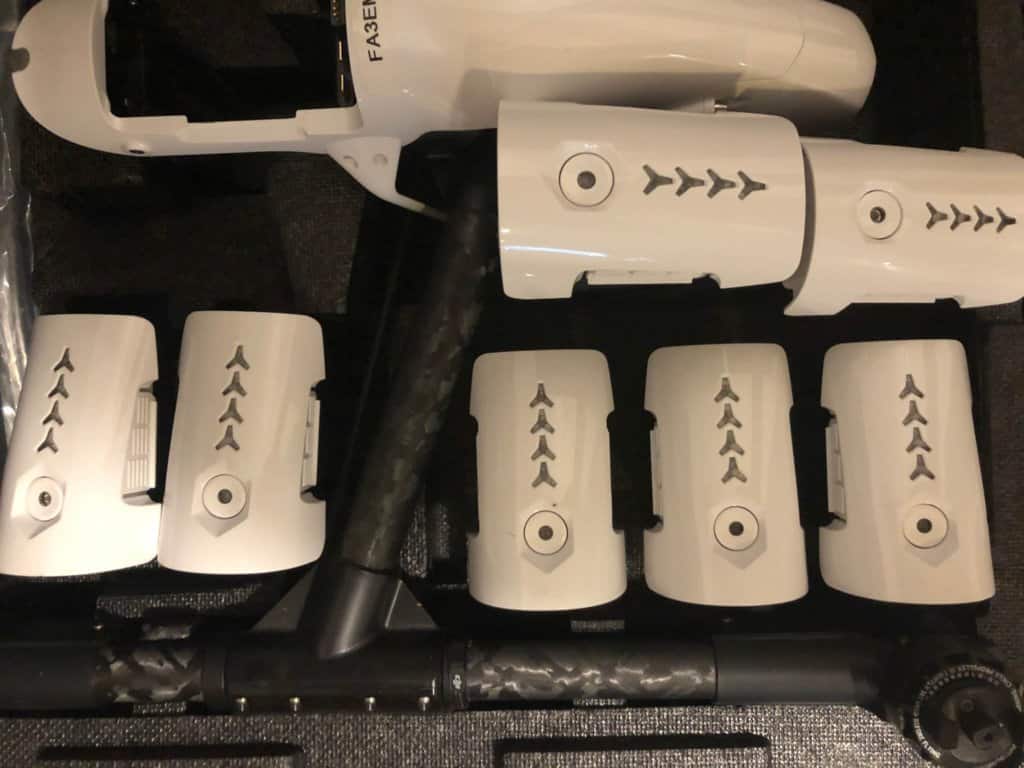Taking your drone with you on a vacation is an awesome adventure, but if you’ve never done it before, you might have a bunch of questions. Whether you’re flying with your drone, or hopping on a cruise ship, this article will answer all of your questions about traveling with drones.
General Tips for Traveling with Drones
Disclaimer: This post includes affiliate links and I will receive a commission if you use them to make a purchase. To be clear, using the links costs you nothing but is a great way to support me if my site brings you value.
At the outset, a couple of things will really help you, no matter how you plan on traveling with drones. Some of my recommendations will vary depending on how you are traveling, but these first two are universal for traveling with drones.
Get a Carrying Case
This one is pretty straight forward but a case for your drone is a must have if you’re traveling. There are a ton of options but I was recently flying with my Mavic Pro and bought these Hermitshell travel cases (link to Amazon).


What I love about them is that they hold everything you need, but not all in one big, bulky case. This makes it way easier to pack the Mavic in my carry-on. I found a few other options to carry the Mavic, and even though it is a small drone, when you have the controller, multiple batteries and charging cables, one single case ends up being pretty large and can take up all of the space you have in a carry-on.
Here are some suggestions for carrying cases that will work with other DJI drones:
| DJI Mavic Pro 2 | DJI Spark | DJI Mavic Air | DJI Phantom 4 Pro | DJI Inspire 2 |
Another thing you can do, especially if you’ve already got a drone backpack or a case like the Phantom 4 Pro comes in, is you can just buy a LiPo Safe bag (link to Amazon). That way your batteries are in a fire safe bag for transport.
Keep the Batteries with You
Ideally, I’d prefer to keep all of my drone stuff with me in a carry on. But if this isn’t possible (and I totally understand that it might not be possible), at the very least, you’ll need to keep the batteries with you. The FAA requires that LiPo batteries are carried with you on a commercial aircraft.
For reasons I’ll talk about below, really the only thing that will be a hang up when flying with your drone is your batteries. The TSA has limits on the types and quantities of batteries you can carry onto an airplane.
Finally, while the cargo hold for checked bags is pressurized just like the cabin, the temperature of the cargo hold can fluctuate more than the cabin itself and these temperature changes aren’t good for LiPo batteries.
Flying with your drone
After you’ve got a carrying case for your drone, controller, batteries, etc. and you make sure to keep the batteries with you, there are a few other things you’ll need to think about when traveling with drones.
Flying in the United States with Your Drone
If you are flying with drone batteries, you will need to know how many watt hours each battery is. The TSA does not limit the number of batteries you can carry, so long as they are under the 100 watt hour limit. If your batteries are over 100 watt hours but less than 160 watt hours, you are limited to two batteries. Anything over 160 watt hours is prohibited on passenger aircraft. You’ll notice that a lot of the batteries are close to the 100 watt hour limit, but not at or over 100 watt hours per battery. I think this is on purpose.
At this point, you’re probably asking yourself how many watt hours your battery is. Here’s a list of the watt hours for the battery on a number of drones.
DJI Drones
Inspire 1 – 129.96 Wh
Inspire 2/Ronin 2 – 97.58
Matrice 600 – 99.9 Wh
Mavic Air – 27.43 Wh
Mavic Pro – 43.6 Wh
Mavic Pro 2 – 59.29 Wh
Phantom 3 – 68 Wh
Phantom 4 – 81.3 Wh
Spark – 16.78 Wh
Parrot Drones
Anafi – 20.52 Wh
MiniDrone – 2 Wh
Parrot – 34.41 Wh
As you can see, the only battery out of the the most common drones that could cause problems is the Inspire 1 battery, clocking in at 129.96 watt hours. I guess I can’t take all seven of my Inspire 1 batteries with me on a flight?

Other drone batteries shouldn’t cause any problems under the current TSA guidelines.
Airline Drone Policies
Another thing to be aware of is your airline’s policy on traveling with drones. While you may be able to get through the TSA security line with your drone, your airline might have additional rules you need to follow. I’ve included the drone policy for a number of the top United States Airlines below (in alphabetical order). To the extent that each airlines doesn’t have a specific policy for drones, I’ve included their limitations on carrying lithium ion batteries.
Alaska Airlines Drone Policy
- Drones without batteries can be checked.
- Batteries rated at 100 watt hours or less can be carried on but not checked
- Batteries more than 100 watt hours but less than 160 watt hours cannot be checked and are limited to 2 spares per person.
Full policy available here on Alaska Airlines’ website.
American Airlines Drone Policy
- Drone Battery cannot exceed 160 Wh
- Drone can be carried on if it (or the box it is carried in) is less than 22x14x9 inches.
Full policy available here on American Airlines’ website.
Delta Airlines Drone Policy
- Each person is limited to a maximum of 20 spare batteries.
- No more than 2 spare batteries rated more than 100 Wh and no more than 160 Wh can be carried on.
Full policy available here on Delta’s website.
Frontier Airlines Drone Policy
- Limit of two loose lithium ion batteries in a carry on bag. Must be in a zip top bag, original retail packaging or have the terminals covered. Lithium ion batteries must weigh less than 8 grams each.
- Lithium ion battery may be checked when it is installed in a device.
Full policy available here on Frontier’s website.
Hawaiian Airlines Drone Policy
- Limit of 2 spare batteries per passenger. The policy says “not to exceed regulatory limits” but its not entirely clear what this means. You may be able to carry two spare batteries rated at up to 160 watt hours but I’d call Hawaiian Airlines before bringing anything over 100 watt hours per battery. Additionally, batteries should be packed in original retail packaging, a protective pouch or with tape across the terminals.
Full policy available here on Hawaiian Airlines’ website.
JetBlue Airways Drone Policy
- Drones can be checked or carried on. If carried on, they must fit in the overhead bin or under the seat and must remain off for the duration of the flight.
- Unlimited number of lithium ion batteries below 100 Wh can be carried on.
- Limit of two spare lithium ion batteries between 100 WH and 160 Wh.
Full policy available here on JetBlue’s website.
Southwest Airlines Drone Policy
- Limit of 20 spare lithium ion batteries per person.
Full policy available here on Southwest’s website.
United Airlines Drone Policy
United does not have a specific policy related to drones but limits LiPo batteries on flights to the following:
- Batteries rated at 100 watt hours or less can be carried on but not checked. Terminals must be covered. (Fireproof LiPo bag above from Amazon might be helpful here).
- Batteries more than 100 watt hours but less than 160 watt hours cannot be checked and are limited to 2 spares per person in most cases, so long as the terminals are covered.
Full policy available here on United Airlines’ website.
Traveling Internationally with Your Drone
If you are traveling with drones internationally, you won’t just need to worry about TSA requirements for drones. The TSA is a United States Governmental entity, but you will also be dealing with the security regulations and laws in the country you are going to as well. I won’t include international drone laws here because that is enough to be its own article. If you’re flying internationally though, make sure you know the laws in that country before you go on your trip.
Bringing Your Drone on a Cruise Ship
Just like each airline has its own drone policy, each cruise line tends to have its own drone policy. No matter if drones are allowed on board your cruise ship or not, they can never be used on board the ship. Based on the policies I’ve seen, drone use on a cruise ship can lead to being forced to disembark from the ship at the next port at your own expense. Ouch.
The other thing that seems to be common is that the cruise lines will not let you use your drone at the port or at any of their private destinations. This is probably partly for safety and partly to have more control over the aerial visuals of their private ports. Either way, you should respect these limitations. Like I said before in my article on flying your drone in National Forests, there are so many beautiful places to capture drone footage and there is no sense in disobeying the rules to get a good shot. Just fly somewhere else.
That said, below are the drone policies of several major cruise lines.
Carnival Cruise Drone Policy (includes Princess Cruise Line)
- Drones are allowed on board Carnival cruise ships but can only be used off the ship while in port. Otherwise, they must be stored in your stateroom.
Full policy available here on Carnival’s website.
Disney Cruise Line Drone Policy
- While drones are not on the “prohibited” list for Disney Cruise Lines, Disney’s policy here does include drones under the section that says “the following items are restricted for safety reasons and should not be brought on board.” Sounds like they’re prohibited to me but you can always ask. If you don’t ask, you don’t know.
Full policy available here on Disney’s website.
Holland America Drone Policy
- Drones are prohibited on Norwegian Cruise Line ships.
Full policy available here on Holland America’s website.
Norwegian Cruise Line Drone Policy
- Drones are prohibited on Norwegian Cruise Line ships.
Full policy available here on Norwegian’s website.
Royal Caribbean Drone Policy (includes Celebrity Cruises)
- Drones are allowed on board Royal Caribbean cruise ships but are only to be used on land and outside of the port area. The drone is to be stored in the stateroom while on board. Additionally, Royal Caribbean does not allow drones to be used as any of their private destinations.
Full policy available here on Royal Caribbean’s website.
I hope this article has been helpful in answering any of your questions about flying with drones. If you have any additional questions, feel free to let me know in the comments and I’ll do my best to find an answer for you. Also, sign up below for regular updates on how to fly your drone legally.

